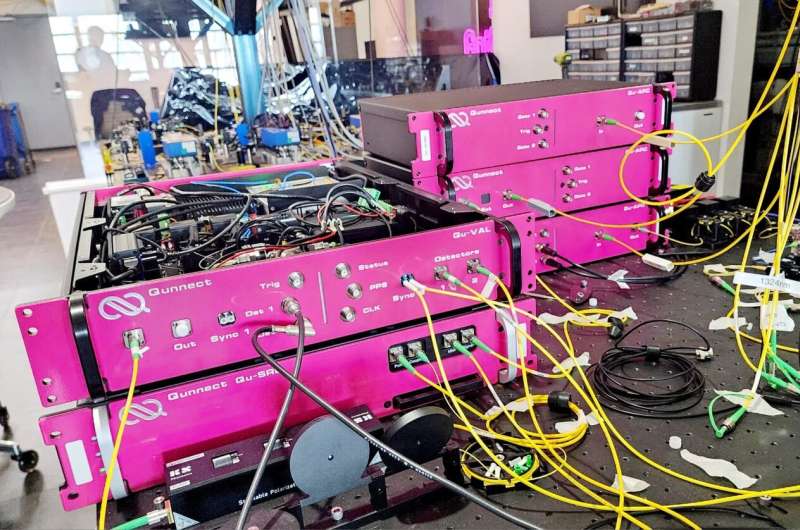To introduce quantum networks into the marketplace, engineers must overcome the fragility of entangled states in a fiber cable and ensure the efficiency of signal delivery. Now, scientists at Qunnect Inc. in Brooklyn, New York, have taken a large step forward by operating just such a network under the streets of New York City.
While others have transmitted entangled photons before, there has been too much noise and polarization drift in the fiber environment for entanglement to survive, particularly in a long-term stable network.
“This is where our work comes into play,” said Mehdi Namazi, co-founder and chief science officer at Qunnect. The team’s network design, methods and results are published in PRX Quantum.
For their prototype network, the Qunnect researchers used a leased 34-kilometer-long fiber circuit they called the GothamQ loop. Using polarization-entangled photons, they operated the loop for 15 continuous days, achieving an uptime of 99.84% and a compensation fidelity of 99% for entangled photon pairs transmitted at a rate of about 20,000 per second. At a half-million entangled photon pairs per second, the fidelity was still nearly 90%.
The polarization of a photon is the direction of its electric field. (This may be easier to understand in the wave picture of light.) You’re perhaps familiar with the phenomenon from polarized sunglasses, which are filters that let light from one polarization direction through but block others, thus cutting down on glare reflected off water, snow and glass, for instance.
Polarized photons are useful because they are easy to create, simple to manipulate (with polarized filters) and to measure.

Polarization-entangled photons have been used in recent years to build large-scale quantum repeaters, distributed quantum computing and distributed quantum sensing networks.
Quantum entanglement, the subject of the 2022 Nobel Prize in Physics, is the peculiar quantum phenomenon in which particles within a quantum state have a connection, sometimes a long distance one, such that measuring the property of one automatically determines the properties of others with which it is entangled.
In their design, an infrared photon of wavelength of 1,324 nanometers is entangled with a near-infrared photon of 795 nm. The latter photon is compatible in wavelength and bandwidth with the rubidium atomic systems, such as are used in quantum memories and quantum processors. It was found that polarization drift was both wavelength and time dependent, requiring Qunnect to design and build equipment for active compensation at the same wavelengths.
To generate these entangled dual-colored photon pairs, coupled input beams of certain wavelengths were sent through a vapor cell enriched with rubidium-78, where they excited the rubidium atoms within the cell, causing an outer electron to transition twice, through a 5p orbital to a 6s orbital.
From this doubly excited state a 1,324 nm photon was sometimes emitted, and a subsequent electron decay produced another photon, of 795 nm.
They sent 1,324 nm polarization-entangled photon pairs in quantum superpositions through the fiber, one state with both polarizations horizontal and the other with both vertical—a two-qubit configuration more generally known as a Bell state. In such a superposition, the quantum mechanical photon pairs are in both states at the same time.
However, in optical cables, such photon systems are more prone to disturbances of their polarization by vibrations, bending and fluctuations in pressure and temperature in the cable and can require frequent recalibrations. Because these types of disturbances can be almost impossible to detect and isolate, let alone mitigate, the Qunnect team built automated polarization compensation (APC) devices to electronically compensate for them.
By sending classical, not entangled, photon pairs of 1,324 nm with known polarizations down the fiber, they could measure how much their polarization drifted or was modified. Polarization drift was measured at four transmission distances: zero, 34, 69 and 102 km, by sending the classical photons zero, one, two or three times around the metropolitan loop under the streets of Brooklyn and Queens. They then used the APCs to correct the polarization of the entangled pairs.
Qunnect’s GothamQ loop demonstration was especially noteworthy for its duration, the hands-off nature of the operation time, and its uptime percentage. It showed, they wrote, “progress toward a fully automated practical entanglement network” that would be required for a quantum internet. Namazi said that “since we finished this work, we have already made all the parts rack-mounted, so they can be used everywhere”—combined equipment that they call Qu-Val.
More information:
Alexander N. Craddock et al, Automated Distribution of Polarization-Entangled Photons Using Deployed New York City Fibers, PRX Quantum (2024). DOI: 10.1103/PRXQuantum.5.030330
© 2024 Science X Network
Citation:
Test of a prototype quantum internet runs under New York City for half a month (2024, August 24)
retrieved 24 August 2024
from
This document is subject to copyright. Apart from any fair dealing for the purpose of private study or research, no
part may be reproduced without the written permission. The content is provided for information purposes only.

